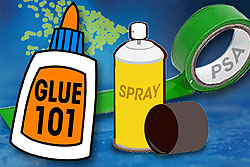There is some general guidance on using glue in kiln forming
processes.
Avoid Glue Altogether
Do not use glue of any kind if at all possible. First look at other ways
of stabilising the pieces. You can place clear frit or powder around or under
the unstable pieces. Of course, if you are firing to less than a contour fuse,
this will show. If the pieces are rolling, you can grind a flat spot to keep
them stable.
Use Minimum Amounts
Use as little as possible if there is no other way to stabilise the
pieces until you get them to the kiln. Use weak glues. Dilute the glues if
water based. Place only a small dot of glue at one place.
Use Care in Placing
Place the glue at the edge of the glass pieces, not underneath. This
allows the glue to burn out cleanly. Placed in the centre, the glue burnout is
trapped under the middle of the glass. This leaves a black mark or a big
bubble.
Avoid Glue with Additives
Use no glue containing additives. Many of these additives will remain
after the adhesive part of the glue has burned off. These will promote
devitrification.
Some Popular Glues
PVA also known as wood glue, white glue,
carpenter's
glue, school glue, Elmer's glue in the US, or PVA glue. This
boils at 112°C/234°F.
Super glue and other
cyanoacrylate glues have a boiling point 54-56°C (129-133°F).
Lacquer and hair spray have
boiling points around 189°C/372°F)
Aloe vera gel has an ignition point
of about 232°C/450°F. So, its boiling point is even lower than CMC.
CMC (carboxymethyl cellulose) includes wallpaper paste, Vitragel and most fusing glues. These have boiling
points around 260°C –270°C (500°F –518°F).
Xanthan gum is a thickener
sometimes used as a kilnforming glue. It boils at 311°C/592°F.
Proprietary kilnforming glues are generally without additives and diluted from the concentrate with demineralised water. They also boil off in the same range as CMC.
All commonly available glues evaporate well below
the “sticky” range of glass. You cannot rely on them to hold the glass in place
until the glass tacks together with the heat.
Quickly fired glue - wet or dry - boils. Sometimes with enough force to move the glass significant distances. So, slow down the initial ramp rate.
The general observation is that if the glass will not stay in place
without glue, it will move during the firing.
Glue is only useful to stabilise pieces in moving the whole assembly to
the kiln. Where possible, build the piece in the kiln without glue at all.
Best of all, use no glue.






